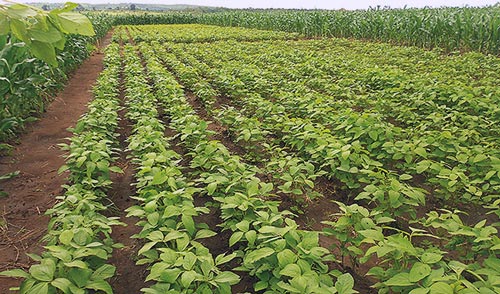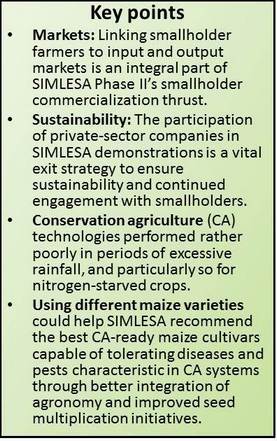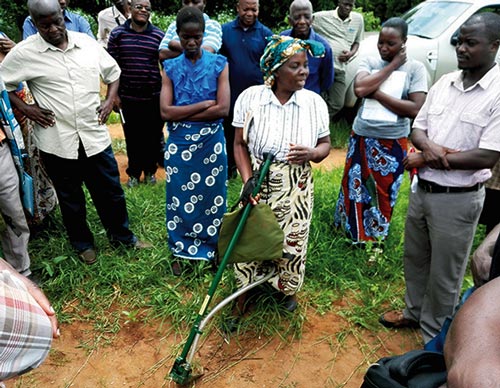
And what solution is this? That Southern Africa smallholder farmers can attain food security and more income through sustainable intensification of maize-based farming systems. This was revealed during recent field learning tours in Malawi and Mozambique.
The annual field tours, which ran from February 9–19, 2015, were organized by CIMMYT’s Sustainable Intensification of Maize-Legume Cropping Systems for Food Security in Eastern and Southern Africa (SIMLESA) project. A total of 224 people (147 men and 77 women) visited 11 sites. The objectives of the field tours were twofold: to examine how the new experiments under SIMLESA Phase II were progressing, and to gather farmers’ feedback on some of the sustainable intensification research interventions.
SIMLESA’s farmer-tested improved maize–legume technologies were showcased during the learning tours. Smallholder farmers interacted with non-governmental organizations (NGOs) and private-sector partners who have shown a great interest in the SIMLESA outscaling approach using lead farmers and learning sites. Some of the sites promote smallholder agriculture development by linking farmers with buyers and agrodealers, and by providing access to credit and technical training.
 In Malawi, the field visits began at Kasungu District, with 16 farmers and technical staff from Mozambique who were on an exchange visit also participating. The group visited outscaling initiatives by the National Association of Smallholder Farmers of Malawi (NASFAM), in which maize–groundnut rotations and maize–pigeonpea systems are being implemented through lead farmers. More than 120 households per field learning site are participating in the demonstrations on each of the five NASFAM sites visited.
In Malawi, the field visits began at Kasungu District, with 16 farmers and technical staff from Mozambique who were on an exchange visit also participating. The group visited outscaling initiatives by the National Association of Smallholder Farmers of Malawi (NASFAM), in which maize–groundnut rotations and maize–pigeonpea systems are being implemented through lead farmers. More than 120 households per field learning site are participating in the demonstrations on each of the five NASFAM sites visited.
In the mid-altitude agro-ecological region of Malawi, new maize varieties have been introduced under SIMLESA Phase II as well as new groundnut and cowpea varieties, in addition to the previously tested soybean varieties in the core on-farm exploratory trials.
Conservation agriculture (CA) exhibited mixed fortunes and presented more opportunities for learning and information sharing. Due to the excessive rains experienced in January, maize on the conventional ridge and furrow farming systems was generally greener and taller than on the CA plots, although the positive rotation effects in CA were clearly evident from the healthy maize crop following soybeans. Also, some maize varieties under CA were more susceptible to diseases such as leaf rust and suffered more from pests such as white grubs which attacked maize roots.
The next stop in Malawi was Mitundu, Lilongwe District, with new crop establishment trials. Here, various new hand-planting tools were being tested, such as jab planters, the Li seeder or planting hoe and the Oklahoma State University (USA) green seeder – all in comparison to the conventional dibble stick and traditional hoe.
The use of a Li seeder has a lot of advantages, including enabling farmers to work faster and therefore saving time, and it does not strain the back,” said Mr James Segula, a smallholder farmer. The Li seeder simultaneously opens a hole in the ground, drops seed and fertilizer, and covers the hole.
Key lessons for the Mozambique and Malawi groups were timely weeding, right maize–legume crop varieties, correct use of fertilizers, residue application and appropriate and safe use of agrochemicals.

Crossing borders to Mozambique’s Angonia District, the group visited exploratory trials which included farmer-preferred maize varieties and the new maize–soybean intercrop system being tested for the first time. In SIMLESA Phase 1, common beans intercrop failed, hence the switch to soybeans. In the central region, members of the national innovation platform which brings on board NGOs such as Total Land Care, Manica Small-Scale Farmers and the Agência de Desenvolvimento Económico de Manica (ADEM) showcased the importance of partnerships. Innovation platforms are fora for information and knowledge sharing on agricultural development. Interesting differences in the tested maize hybrid and open pollinated varieties (OPV) included better leaf diseases tolerance from the hybrid Pristine, in contrast to early maturity characteristics from the OPV.
SIMLESA’s innovation platform is working with partners such as ADEM to facilitate farmers’ access to inputs, link them to financial institutions to access credit and connect them to markets for their produce. Mr Domingos Dias, SIMLESA–Mozambique National Coordinator, said: “We commend this approach of linking farmers to input suppliers and credit providers. Lessons learned, and experience gained over the years, indicate that training alone without market links is not profitable.”
Links: More on SIMLESA – in slides | project website
 Innovations
Innovations 
